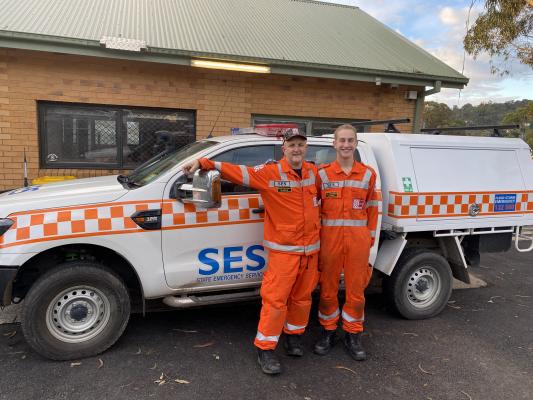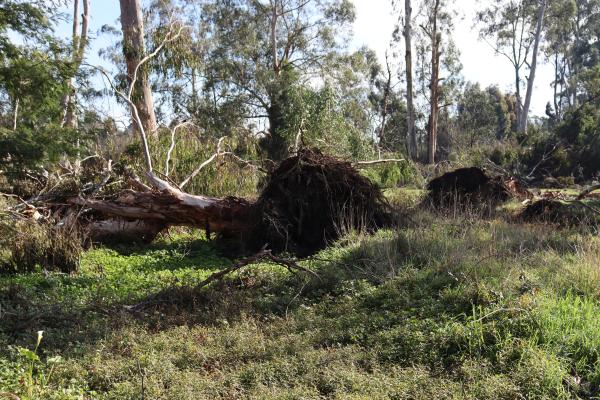
By Mikayla van Loon
It has been a month since wild storms raged throughout the eastern suburbs, Yarra Valley and Dandenong Ranges, so Star Mail caught up with Lilydale SES unit controller Shaun Caulfield to see how things were going.
Up until two weeks ago, Lilydale SES were still helping in the recovery and relief phase, coordinating donations and community outreach but this has now been handed over to Yarra Ranges Council.
“There’s still a lot of tree crews and arborists working up there and clearing damaged trees. As far as work for the SES is concerned it’s gone back to business as usual but there’s still a lot of people who are displaced from their houses and it’s going to take quite some time before a lot of the premises up there are repaired and habitable again,” Mr Caulfield said.
Lilydale CFA compiled a list of statistics of affected properties and the numbers speak for themselves: 76 damaged and uninhabitable, 51 damaged but habitable and 41 affected but not structurally.
But with thousands of trees having already fallen, crews are now working to assess and secure compromised trees which still have the potential to fall.
“It’s quite an eerie look up there because there’s a lot more light hitting the ground than there was a few weeks ago because there’s a lot less big trees,” Mr Caulfield said.
“The issue now is the damaged ones that are still upright that need to be managed to make safe and really, that’s the current challenge for everyone up there.
“Putting supports in place to help people with large trees on private property or that are on council land that border private property, they need to help them manage those because there aren’t any small trees in Kalorama, so everything’s huge and it’s just a lot of work.”
Mr Caulfield said the council and Bushfire Recovery Victoria are handling the next phase of community consultation and feedback.
“Recipients of the assistance have certainly voiced their concerns about services that were delivered adequately or weren’t delivered to their expectation and hopefully the council are doing something to rectify those issues.
“It’s important to consult the end user which is the community, the people impacted by whatever the disaster is need to have input into the services that are delivered to them, whether that’s during the response phase or whether that’s the recovery or the relief phases, there’s no point in agencies delivering things that people don’t need or don’t want.”
A similar process will also start happening for the agencies involved in the initial and post response to the damage known as an after action review.
“That’s when all the major players come together and discuss the things that went well, the things that didn’t go well, the things that we really could and should do differently in the future and that doesn’t always mean better but things that could be done differently for better effect or better impact.
“There’s always something to learn out of something like this regardless of whether you think it went well or didn’t go well at the time, there’s always opportunities to refine the process.”
Mr Caulfield said he has been putting together a list of things he would like to bring up at the review process, including the potential for setting up a new unit in Olinda or Kalorama, as well as tabling the idea of a full or satellite unit in Yarra Glen.
Although completely unpredictable, Mr Caulfield said the severity of the storms was not made known to the emergency services.
“We kind of got a little bit caught off guard insofar as the weather briefing didn’t indicate the severity of the storm and that’s not necessarily a failure of the weather bureau, that’s the unpredictability of weather, particularly in Melbourne.
“There was a forecast that there would be some wind, no worse than dozens of other forecasts that we’ve had in the past and it would seem that this caught the weather bureau off guard as well because obviously it was more intense than forecast models suggested.”
Now the community’s attention, as well as the SES, has turned to healing and sharing stories about their experiences.
“That process and pathway to healing is something that you don’t necessarily have to have facilitated by others but for some people that will just be achieved by sitting around, sharing their individual experiences and then coming out the other side towards how they’re getting on and how they’re recovering.”
Lilydale SES are just starting to get back to normal, with regular Monday night training, after working behind the scenes offering relief and support at community meetings.
“People are coping well, for a while people were very tired and we had a lot of people put in quite a significant amount of hours,” Mr Caulfield said.
“As we start to come back to something that is a little bit more akin to normal, people are starting to get back into the normal groove but it’s taken a few weeks for things to really settle down and for things to start feeling like normal, you can still feel tired from it for three or four weeks later.”










